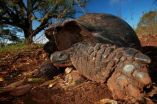(Press-News.org) MANHATTAN, Kan. -- When it comes to stopping illness, social media posts and tweets may be just what the doctor ordered.
A Kansas State University-led research team is looking at social media as a tool to reduce and prevent diseases from spreading. Researchers are studying whether a well-timed post from a public authority or trustworthy person could be as beneficial as flu shots, hand-washing or sneezing into an elbow.
"Infectious diseases are a serious problem and historically have been a major cause of death," said Faryad Sahneh, Kansas State University doctoral candidate in electrical engineering who is modeling the spread of epidemics in an effort to reduce them. "During the last decades there has been a huge advancement in medication and vaccination, which has helped save many peoples' lives. But now there also has been a revolution in communication and information technology that we think could be used to develop an even more robust preventative society against infectious diseases."
Sahneh is working on the project with Kansas State University researchers Caterina Scoglio, associate professor of electrical and computer engineering and expert in complex network modeling; Gary Brase, associate professor of psychology who studies how people make decisions; and Walter Schumm, professor of family studies and human services who studies family dynamics.
Collaborators also include Daniel J. Kruger, a public health scientist at the University of Michigan's School of Public Health; Fahmida N. Chowdhury, an expert in dynamical systems theory and control at the National Science Foundation; and Michael L. Parchman, director of the MacColl Center for Health Care Innovation.
According to Scoglio, having research collaborators from a wide range of relevant disciplines helps the team develop more comprehensive and accurate models that account for realistic human behavior.
Brase, for example, is collecting data by surveying college-age students about social media and what preventative measures they use against illness.
Results indicate that a majority of participants get their information predominately from Facebook and a few other social media sites. Moreover, the majority of participants stated they would be willing to increase preventative behaviors such as washing their hands more, taking vitamins or getting a flu shot if asked to do so.
"However, we also saw that restricting contact with family and friends is something that people are not willing to do," Brase said. "If you think about how diseases are spread, one of the best things you can do is to not interact with other people. But we've seen that this is one thing that people are not very excited about doing."
As well as gathering information about human behavior, the team is identifying the various groups that need to be reached with social media.
One critical group is individuals such as teachers or public officials who regularly interact with a large number of the public, Scoglio said. If exposed to a disease, these individuals can potentially infect everyone they interact with throughout the day. Reaching that group, though, could help suppress the disease spreading.
"If 30 people in that group get a flu vaccine, they will have less probability of getting the flu," Sahneh said. "But, by being vaccinated, it's also benefiting all who come into contact with those 30 people because there is now a reduced chance of the flu being transmitted by those 30 individuals. So reaching that group is pretty important."
Researchers are also exploring who is the most effective or influential at distributing information through social media.
"One thing we're discussing is whether it would be better to receive recommendations or advice from someone people know and trust personally, like a friend or the university president, or from someone like the Centers for Disease Control and Prevention, which is an authority on the subject but has no personal connection to most people," Scoglio said. "It may be something where a best friend has more influence than a public health official."
The team's first study, "On the existence of a threshold for preventative behavioral responses to contain epidemic spreading," was recently published in the open-source Scientific Reports journal. Sahneh was the lead author. The study found that if individuals quickly adopt the appropriate preventative behavior, a growing infection can be contained. The study can be read at: http://bit.ly/Omv5Hc.
In December, Sahneh is presenting new findings on an optimal dissemination network of health information to the scientific community at the 51st IEEE Conference on Decision and Control. Results suggest that not only vaccinating critical individuals, but also facilitating the circulation of health information to and from those critical individuals greatly helps in suppressing infectious diseases.
### END
Researchers explore social media as preventative method for infectious diseases
2012-11-27
ELSE PRESS RELEASES FROM THIS DATE:
Man's best friend: Common canine virus may lead to new vaccines for deadly human diseases
2012-11-27
Athens, Ga. – Researchers at the University of Georgia have discovered that a virus commonly found in dogs may serve as the foundation for the next great breakthrough in human vaccine development.
Although harmless in humans, parainfluenza virus 5, or PIV5, is thought to contribute to upper respiratory infections in dogs, and it is a common target for canine vaccines designed to prevent kennel cough. In a paper published recently in PLOS ONE, researchers describe how this virus could be used in humans to protect against diseases that have eluded vaccine efforts for decades.
"We ...
Galapagos tortoises are a migrating species
2012-11-27
This press release is available in German.
The Galapagos giant tortoise, one of the most fascinating species of the Galapagos archipelago, treks slowly and untiringly across the volcanic slopes. Scientists of the Max Planck Institute for Ornithology in Radolfzell, together with the Charles Darwin Foundation, have used GPS technology and modern 3D acceleration measurements to find out that especially the dominant male tortoise wanders up to 10 kilometres into the highlands of the island. Only the fully grown animals migrate, the young tortoises stay year round in ...
Do missing Jupiters mean massive comet belts?
2012-11-27
Using ESA's Herschel space observatory, astronomers have discovered vast comet belts surrounding two nearby planetary systems known to host only Earth-to-Neptune-mass worlds. The comet reservoirs could have delivered life-giving oceans to the innermost planets.
In a previous Herschel study, scientists found that the dusty belt surrounding nearby star Fomalhaut must be maintained by collisions between comets.
In the new Herschel study, two more nearby planetary systems – GJ 581 and 61 Vir – have been found to host vast amounts of cometary debris.
Herschel detected ...
Researchers study cry acoustics to determine risk for autism
2012-11-27
Autism is a poorly understood family of related conditions. People with autism generally lack normal social interaction skills and engage in a variety of unusual and often characteristic behaviors, such as repetitive movements. While there is no specific medical treatment for autism, some success has been shown with early behavioral intervention.
Understanding the importance of early diagnosis, researchers at Women & Infants' Brown Center for the Study of Children at Risk in collaboration with researchers at University of Pittsburgh have been studying the cry acoustics ...
Flu outbreaks predicted with weather forecast techniques
2012-11-27
Contact: David Hosansky
hosansky@ucar.edu
303-497-8611
Zhenya Gallon
zhenya@ucar.edu
303-497-8607
National Center for Atmospheric Research/University Corporation for Atmospheric Research
Flu outbreaks predicted with weather forecast techniques
BOULDER – Scientists at Columbia University and the National Center for Atmospheric Research have adapted techniques used in modern weather prediction to generate local forecasts of seasonal influenza outbreaks. By predicting the timing and severity of the outbreaks, this system can eventually help health officials ...
Cell Transplantation reports islet cell advancement increases impact on transplantation
2012-11-27
Putnam Valley, NY. (Nov. 27, 2012) – A study published in the current issue of Cell Transplantation (21:8), now freely available on-line at http://www.ingentaconnect.com/content/cog/ct/ , reports that a team of researchers in South Korea have successfully engineered islet cell clusters (ICCs) that will improve pancreatic islet transplantation and offer promise for curing diabetes mellitus.
Carried out by collaborating researchers at three universities in Seoul, Korea, the new process of creating ICCs included delivering a gene to single islet cells that increased their ...
An energy conscious workforce: New research looks at how to encourage staff to go green
2012-11-27
As homeowners we are becoming cannier about turning down the thermostat to save our pennies and the planet but are we as energy conscious when we get to work?
A new £1.3m project, being led by researchers at The University of Nottingham, is to look at people's attitudes to energy consumption in the workplace and how to encourage colleagues to work together in reducing their organisation's carbon footprint.
Drawing on technical expertise at Nottingham's Horizon Digital Economy Research and design skills of experts at The University of Southampton, the five-year study ...
Study suggests different organ-derived stem cell injections improve heart function
2012-11-27
Putnam Valley, NY. (Nov. 27, 2012) – A study published in the current issue of Cell Transplantation (21:8), now freely available on-line at http://www.ingentaconnect.com/content/cog/ct/, has found that when mesenchymal cells derived from skeletal muscle (SM-MSCs) or adipose tissue (ADSCs) were injected into the heart muscle (myocardium) of separate groups of laboratory rats that had suffered a myocardial infarction, rats in both groups experienced significantly improved left ventricle function and smaller infarct size after cell therapy.
The study, carried out by researchers ...
Tracking pollution from outer space
2012-11-27
The thickest layers of global smog — caused by traffic, industry, and natural minerals, among other factors — are found over the world's megacities. But getting an accurate measurement of pollution is no easy task. On-the-ground monitoring stations do not always provide the most accurate picture —monitoring stations depend heavily on local positioning and some cities put stations in urban centers, while others build on the edge of a city.
Now Prof. Pinhas Alpert of Tel Aviv University's Department of Geophysics and Planetary Sciences and head of the Porter School of Environmental ...
Illuminating the no-man's land of waters' surface
2012-11-27
Water repelling molecules are said to be hydrophobic. The hydration – or formation of water interfaces around hydrophobic molecules – is important for many biological processes: protein folding, membrane formation, transport of proteins across an interface, the transmission of action potentials across membranes. It is involved as well in the process of creating mayonnaise, or in the fact that you can get rid of fat with soap. Hydrophobic interfaces although long studied, are poorly understood.
Here's an amusing kitchen-table experiment to illustrate waters unusual properties: ...



